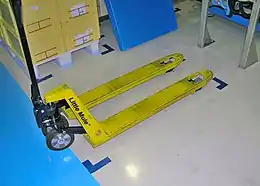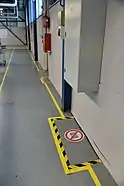Floor marking tape
Floor marking tapes are adhesive tapes used to mark hazards, divide spaces, create aisles, or provide directions. They are commonly used in industrial and manufacturing facilities for floor marking. They are made of multiple different materials, including PVC and vinyl, and vary in thickness from 5-mils to 55-mils for a wide range of durability options for manufacturing facility floor marking. The best floor marking tapes are usually 50 to 60 mils thick. Most tapes come in a variety of color options and even hazard patterns to meet U.S. Occupational Safety and Health Administration/ANSI requirements and other safety standards. Some tapes are made with higher reflectivity and may even glow in the dark.
Floor marking tapes can also be useful for helping workers put materials and equipment back in the right place, making it a key 5S, Lean manufacturing implementation tools.[1] Creating distinctions between finished goods, raw goods, to-be-repaired goods, and equipment ensures mistakes are minimized and productivity and safety are both at the highest levels.
Usage
Floor markings are used in United States in industrial workplaces as a way of complying with requirements in OSHA 1910.22, which requires that aisles and passageways be marked in areas where material handling equipment, such as forklifts are used.[2]
Starting in 2009, the International Fire Code required structures over 75 feet (23 m) to have exit paths and stairway steps marked by a luminous path to guide people evacuating to the exit. A way of satisfying this requirement is photoluminescent tape, which glows in darkness without any external power source.[3]
5S and Lean manufacturing
Floor markings are an important part of step 2 of 5S, Set In Order (Seiton), organizing workspaces by denoting walkways, work spaces and storage spaces. In addition, floor markings are used to denote requirements to keep the area in front of fire extinguishers, fire hoses, first aid equipment and exits clear.[1]
Hiroyuki Hirano's 5 Pillar of the Visual Workplace, proposed a scheme for markings that used not only color, but the size of the line and if the line was solid or broken, to convey meaning, expanding the possible messages that could be communicate, with only three colors.[1]
| Color | Line type and width | Meaning |
|---|---|---|
Yellow | Solid line 100 mm (3.9 in) | Area divider line |
Yellow | Broken line 100 mm (3.9 in) | Exit and entry lines |
Yellow | Broken line 100 mm (3.9 in) | Door swing lines |
Yellow | Arrow | Designate traffic direction flow |
| White | Solid line 50 mm (2.0 in) | Place markers for in-process inventory |
| White | Corner line 50 mm (2.0 in) | Place markers for operations |
| White | Broken line 30 mm (1.2 in) | Place marker for non-production and inventory items (Ashtrays, clipboards, etc |
Red | Solid line 30 mm (1.2 in) | Storage area for defective goods |
Black Yellow | Striped Line 30 mm (1.2 in) | Marking hazards |
Materials
Tape
Tapes are replacement for paints for floor marking. Tapes are much faster and easier to install and replace, which dramatically reduces down times related to painting aisles and rails. Many floor tapes are scuff and break resistant, unlike paints that will chip and scratch off. Tapes that are printed with stripes, chevrons and Sillitoe tartan patterns are far easier and faster to install than the same patterns when painted. Floor tapes also have a storage advantage, with being less temperamental, with longer shelf lives than paints. However, tape does have drawbacks. It can tear, peel and fail to adhere to some floor surfaces. Further, tape can introduce a trip hazard if it's peeling. Overall there are numerous advantages to using good quality, durable floor tape over paint.[4]
References
- Hirano, Hiroyuki (1995). "6 - The Second Pillar: Orderliness". 5 Pillars of the Visual Workplace: The Sourcebook for 5S Implementation (First ed.). Portland, Oregon: Productivity Press. pp. 96 - 104. ISBN 1-56327-047-1.
- Occupational Safety and Health Admin., Labor, 29 CFR § 1910.22 General requirements. (2011).
- International Code Council (2009). "International Fire Code - 2009" (PDF). International Code Council. pp. 144–145. Retrieved 15 November 2019.

